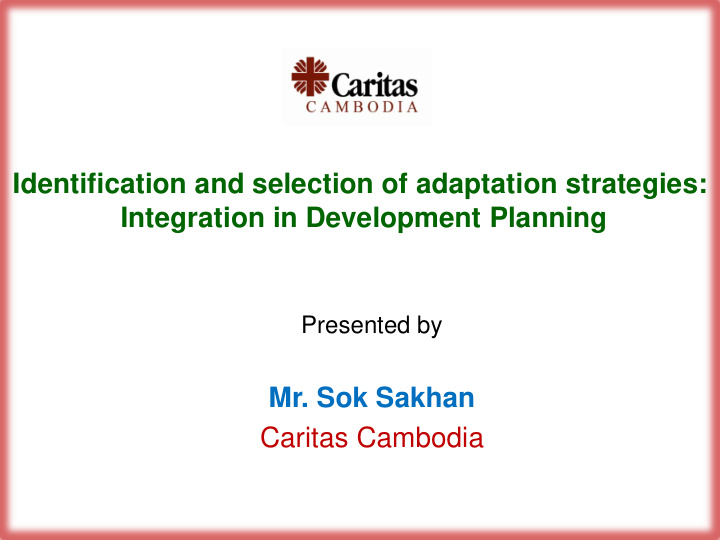



Identification and selection of adaptation strategies: Integration in Development Planning Presented by Mr. Sok Sakhan Caritas Cambodia
Presentation Outline • Integrated Development Program 1. Program Goals and Objectives 2. Program Implementation’s Results 3. Challenges 4. Lessons learned
Integrated Development Program Goal: To enable the target community resilience and sustainable livelihood in 190 villages in 47 communes in 19 districts in 7 provinces of Kandal, Kampong Thom, Kampong Cham, Preah Vihear, Battambang, Siem Reap and Mondulkiri through integrated disaster risk reduction and climate change adaptation into development program.
Integrated Development Program Objectives: 1. To ensure food security for climate and disaster affected people. 2. To improve irrigation system to ensure water source for agriculture and sustainable livelihood to reduce the climate risk. 3. To improve local infrastructure in disaster prone areas. 4. To improve the community health and sanitation through awareness building on health care and hygiene.
Methodology • Integrated the DRR and CCA in all target program activities of Caritas Cambodia in 7 provinces. • DRR and CCA has been prioritized in the strategy of the Integrated Development Program in order to promote sustainable livelihood. • Established networking for disaster management and preparedness at all levels in order to prevent and mitigate the effect of natural calamities and to assist and enable the victims of natural calamities to restore their normal living and hopefully. • Each VDA representative has been promoted to be in CCDM structure and worked together for disaster management and preparedness and response.
Achievement To ensure food security, Caritas have promoted livelihood alternative which are able to support their living even they are challenging with disasters: -Livestock -Home gardening -Rice bank
Achievement Promote the poor farmers to cultivate the early rice which they could harvest at least twice a year and at least 4 to 5 tons per hectare.
Achievement Promote the poor farmers to use organic manure and stop using chemical fertilizers and pesticides through skills training support on making compost, EM etc and through demonstration farm.
Achievement Water source management: To ensure sustainable crops cultivation of the small farming families Caritas has supported for irrigation system development through constructing and repairing canals, check dam and water gates, water ponds for both community and individual family, tube wells, water pump machine station installment and water pump machines. The poor farming families are able to cultivate rice twice to three times per year.
Achievement Two water pump stations were provided to the VDA of two provinces of Kandal and Kampong Thom for protecting rice and other crops while drought occurred. At least 2 or 3 water pump machines were provided to each village to support the rice and non rice cultivation while it is lacked of rainfall or drought occurred during the rainy season. Water gate and check dam were constructed in Kg. Thom, Kg. Cham and Battambang province for conservation of the water to use in the dry season.
Achievement Road with culvert construction and bridge have been constructed to protect flood water where they could be able to keep communication and transportation in the their village during flood situation.
Achievement Water and sanitation Supported for constructing hand pumps and ring wells for household use such as washing, bathing, drinking.
Achievement Promote the community members to take an opportunity to do other activities such as chicken, duck and pig raising, small business, handicraft and micro enterprise development (MED) in order to generate household income through saving and credit program with providing both financial and technical support from Caritas.
Challenges • Capacity to manage disasters of the community is limited • Coping mechanism of the community on disasters and climate change is limited of some of target communities. • Capacity of the staff to help the community to manage disasters is limited. • Participation of the community is limited
Lessons Learned • Good coordination and cooperation from government and local authority. • Acceptation of the community members to use the agriculture technique due to actual practice and sharing the new technical to other. • Participation of some communities in some of target areas both labors and their resources to develop their community. • Crops variation. • Community Based Disaster Preparedness • Family Based Disaster Preparedness
Recommend
More recommend